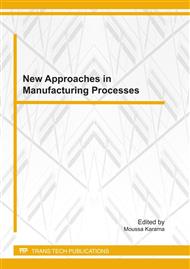p.49
p.57
p.67
p.77
p.85
p.95
p.107
p.117
p.125
Modeling of the Superficial Laser Shock Peening Treatment Process: Application on a Titanium Aircraft Turbine Engine Blade
Abstract:
This paper presents a numerical simulation of the Laser Shock Peening (LSP) process using Finite Element Method (FEM). The majority of the controlling parameters of the process have been taken into account. The LSP loading has been characterized by using a repetitive time Gaussian increment pressure applied uniformly at the impacted zone. The used behavior law of the treated material is supposed Johnson Cook elastic-viscous-plastic coupled with damage. The proposed model leads to obtain the surface modifications (i) the in-depth residual stresses profile, (ii) the induced plastic strains profile, (iii) the geometrical surface modification of the impacted zone and (iv) the superficial damage which can be induced in few cases, where the operating conditions are not well chosen and optimized. An aeronautical application of LSP has been carried out on aircraft turbine engine blade made by Ti-6Al-4V super alloy. This mechanical treatment is applied in order to increase the durability of titanium fan blades and decrease their sensitivity to foreign object damage (FOD). The resulting surface compressive residual stress significantly improves the high-cycle-fatigue properties of the component and greatly increases resistance to blade failure. Finally, we studied the feasibility of the influence of LSP treatment on the phenomenon of crack propagation by introducing a superficial crack defect on the edge of the studied blade structure. This is physically consistent and leads to optimize the operating conditions in order to limit the damage risks.
Info:
Periodical:
Pages:
85-94
Citation:
Online since:
June 2011
Authors:
Price:
Сopyright:
© 2011 Trans Tech Publications Ltd. All Rights Reserved
Share:
Citation:


